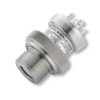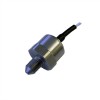Ceramic pressure sensors are devices which have sensing diaphragms made from Alumina (Al2O3) with either a screen printed thick film strain gauge circuit or a variable capacitance cell.
Ceramic diaphragms are very inert and provide a high level of protection from aggressive chemicals.
Featured chemical resistant measurement products
 High sulphuric acid content resistant 16 bar g 4-20mA water pressure sensor - This 4-20mA pressure sensor with PVDF, ceramic, and FKM construction is designed for water with high sulfuric acid content up to 10%. Ideal for chemical processing and wastewater treatment.
High sulphuric acid content resistant 16 bar g 4-20mA water pressure sensor - This 4-20mA pressure sensor with PVDF, ceramic, and FKM construction is designed for water with high sulfuric acid content up to 10%. Ideal for chemical processing and wastewater treatment. LMK331 Screw-In Ceramic Level Transmitter - Level pressure sensor with semi-flush ceramic diaphragm and stainless steel or PVDF wetted parts in ranges from 0-4 to 600mH2O gauge.
LMK331 Screw-In Ceramic Level Transmitter - Level pressure sensor with semi-flush ceramic diaphragm and stainless steel or PVDF wetted parts in ranges from 0-4 to 600mH2O gauge.
Glossary of Pressure Sensor technical terms
- Digital Compensation
- Dry Cell
- Dry/Dry
- HART®
- Isolation Diaphragm
- LVDT – Linear Variable Differential Transformer
- Pressure Sensors
- SOI – Silicon on Insulator
- Stainless Steel Pressure Sensors
- Static Line Pressure
- Wet/Dry
- Wet/Wet
Help from Pressure Sensor resources
- Pressure Sensor Accuracy Specifications
- Supply voltage and load resistance considerations for pressure transmitters
- Symptons and Causes of Damage to Pressure Transducer Diaphragms
- How to Connect a 4-20mA Current Loop Pressure Transmitter
- What is difference between working, burst and over pressure
- Measuring vacuum as a negative gauge pressure using a dp sensor
- Measuring liquid level in a tank using a dp sensor
- Measuring density of a liquid using a dp sensor
- Pressure Sensor Technology Comparative Guide

